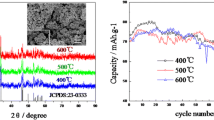Abstract
The effect of polyaspartate (PASP) on the gel properties and performance of gel valve-regulated lead-acid (VRLA) batteries is reported. The presence of PASP in the gelled electrolyte has a marginal effect on the gelling process and gel strength. Cyclic voltammetry indicates that the addition of PASP does not affect the main reaction of the VRLA battery, but slightly suppresses the hydrogen evolution reaction. However, a concentration level of PASP seems not to affect the degree of suppression. The battery performance was evaluated under a 100 % depth of discharge (100 % DoD) over a wide temperature range (0–60 °C), and after a 3-month storage period and under partial-state-of charge (PSoC) conditions at normal and high charge/discharge rates. The addition of 0.005 % (w/v) PASP in the gelled electrolyte slows down the growth of lead sulfate crystals on the negative plate during the battery operation leading to a substantial improvement in the performance of the gel VRLA batteries. By combining the advantages of the gelled electrolyte structure and the presence of PASP in the gelled electrolyte, the gel VRLA batteries provide a superior discharge capacity and long cycle life under all 100 % DoD and PSoC conditions studied.








Similar content being viewed by others
References
Hernandez JC, Soria ML, Gonzalez M, Garcia-Quismondo E, Munoz A, Trinidad F (2006) Studies on electrolyte formulations to improve life of lead acid batteries working under partial state of charge conditions. J Power Sources 162:851–863
Tantichanakul T, Chailapakul O, Tantavichet N (2013) Influence of fumed silica and additives on the gel formation and performance of gel valve-regulated lead-acid batteries. J Ind Eng Chem 19:2085–2091
Voss E, Hullmeine U, Winsel A (1990) Behaviour of the PbO2/PbSO4 electrode in sulphuric acid containing tin ions. J Power Sources 30:33–40
Garche J, Döring H, Wiesener K (1991) Influence of phosphoric acid on both the electrochemistry and the operating behavior of the lead/acid system. J Power Sources 33:213–220
Badawy WA, EI-Egamy SS (1995) Improvement of the performance of the positive electrode in the lead/acid battery by addition of boric acid. J Power Sources 55:11–17
Dietz H, Hoogestraat G, Laibach S, Von Borstel D, Wiesener K (1995) Influence of substituted benzaldehydes and their derivatives as inhibitors for hydrogen evolution in lead/acid batteries. J Power Sources 53:359–365
Ferreira AL (2001) Battery additives: any influence on separator behavior? J Power Sources 95:255–263
Petkova G, Nikolov P, Pavlov D (2006) Influence of polymer additive on the performance of lead-acid battery negative plates. J Power Sources 158:841–845
Pavlov D, Nikolov P (2012) Lead–carbon electrode with inhibitor of sulfation for lead-acid batteries operating in the HRPSoC duty. J Electrochem Soc 159:A1215–A1225
Rezaei B, Mallakpour S, Taki M (2009) Application of ionic liquids as an electrolyte additive on the electrochemical behavior of lead acid battery. J Power Sources 187:605–612
Tantichanakul T, Chailapakul O, Tantavichet N (2011) Gelled electrolytes for use in absorptive glass mat valve-regulated lead-acid (AGM VRLA) batteries working under 100 % depth of discharge conditions. J Power Sources 196:8764–8772
Mansfeld F, Hsu H, Örnek D, Wood TK, Syrett BC (2002) Corrosion control using regenerative biofilms on aluminum 2024 and brass in different media. J Electrochem Soc 149:B130–B138
Örnek D, Wood TK, Hsu CH, Mansfeld F (2002) Corrosion control using regenerative biofilms (CCURB) on brass in different media. Corros Sci 44:2291–2302
Örnek D, Wood TK, Hsu CH, Sun Z, Mansfeld F (2002) Pitting corrosion control of aluminum 2024 using protective biofilms that secrete corrosion inhibitors. Corrosion 5:761–767
Nitǎ LE, Chiriac AP, Popescu CM, Neamtu I, Alecu L (2006) Possibilities for poly(aspartic acid) preparation as biodegradable compound. J Optoelectron Adv M 8:663–666
Zhang W, Xiong R, Wei G (2009) Biological flocculation treatment on distillery wastewater and recirculation of wastewater. J Hazd Mater 172:1252–1257
Japanese Standards Association (2003) Japanese Industrial Standard, Small-size valve regulated lead – acid batteries Plate 1: General requirements, functional characteristics Methods of test. JIS C 8702–1
Tang Z, Wang J, Mao X-X, Shao H, Chen Q, Xu Z, Zhang J (2007) Investigation and application of polysiloxane-based gel electrolyte in valve-regulated lead-acid battery. J Power Sources 168:49–57
Lam LT, Newnham RH, Ozgun H, Fleming FA (2000) Advanced design of valve-regulated lead–acid battery for hybrid electric vehicles. J Power Sources 88:92–97
Hariprakash B, Gaffoor SA, Shukla AK (2009) Lead-acid batteries for partial-state-of-charge applications. J Power Sources 191:149–153
Berndt D (2003) Maintenance-free batteries: based on aqueous electrolyte lead-acid, nickel/cadmium, nickel/metal hydride: a handbook of battery technology, 3rd edn. Research Studies Press Ltd, Hertfordshire
Lambert DWH, Greenwood PHJ, Reed MC (2002) Advances in gelled-electrolyte technology for valve-regulated lead-acid batteries. J Power Sources 107:173–179
Lam LT, Haigh NP, Phyland CG, Urban AJ (2004) Failure mode of valve regulated lead-acid batteries under high-rate partial-state-of-charge operation. J Power Sources 133:126–134
Lam LT, Louey R, Haigh NP, Lim OV, Vella DG, Phyland CG, Vu LH, Furukawa J, Takada T, Monma D, Kano T (2007) VRLA ultrabattery for high-rate partial-state-of-charge operation. J Power Sources 174:16–29
Acknowledgments
The authors express their gratitude to the Thailand Research Fund (IUG5280002 and IRG5780001), Faculty of Science of Chulalongkorn University and N.V. Battery Ltd. Partnership for financial support during the course of this study. The authors also thank Dr. Robert Butcher for helpful English suggestions and grammar corrections.
Author information
Authors and Affiliations
Corresponding author
Rights and permissions
About this article
Cite this article
Tundorn, P., Chailapakul, O. & Tantavichet, N. Polyaspartate as a gelled electrolyte additive to improve the performance of the gel valve-regulated lead-acid batteries under 100 % depth of discharge and partial-state-of charge conditions. J Solid State Electrochem 20, 801–811 (2016). https://doi.org/10.1007/s10008-015-3117-z
Received:
Revised:
Accepted:
Published:
Issue Date:
DOI: https://doi.org/10.1007/s10008-015-3117-z




